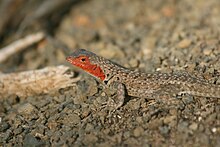Tropidurus: Difference between revisions
No edit summary |
No edit summary |
||
| Line 48: | Line 48: | ||
*''[[Tropidurus xanthochilus]]'' |
*''[[Tropidurus xanthochilus]]'' |
||
[[Category:Tropidurids]] |
[[Category:Tropidurids]] |
||
[[Category:Endemic fauna of the Galápagos Islands|Lava Lizard]] |
|||
[[pt:Tropidurus]] |
[[pt:Tropidurus]] |
||
Revision as of 02:30, 24 October 2008
| Tropidurus | |
|---|---|

| |
| Female Tropidurus (Microlophus) grayi photographed on Floreana Island, Galapagos. | |
| Scientific classification | |
| Kingdom: | |
| Phylum: | |
| Class: | |
| Order: | |
| Family: | |
| Genus: | Tropidurus
|
The reptile genus Tropidurus includes several species of ground lizard. It includes seven which are endemic to the Galapagos Islands, where collectively known as lava lizards, although these commonly are placed in the genus Microlophus instead. The distribution of these lizards and their variations in shape, colour and behaviour show the phenomenon of adaptive radiation so typical of the inhabitants of this archipelago. One species occurs on all the central and western islands, which were perhaps connected during periods of lower sea levels, while one species each occurs on six other more peripheral islands. All have most likely evolved from a single ancestral species. Other Tropidurus species are found on the South American mainland, especially in the Amazon Rainforest.

Males and females of all Tropidurus species are marked differently. The male is usually much larger than the female, and its body is more brightly coloured and distinctly patterned. The average size of lizards varies greatly from habitat to habitat as does the pattern of body markings. Markings vary considerably, even within an individual species. Like many lizards, they show changes of colour with mood and temperature. Members of the same species occurring in different habitats aiso show colour differences. Thus animals living mainly on dark lava are darker than ones which live in lighter, sandy environments.
Species include:
- Tropidurus amathites
- Tropidurus bogerti
- Tropidurus callathelys
- Tropidurus catalanensis
- Tropidurus chromatops
- Tropidurus cocorobensis
- Tropidurus divaricatus
- Tropidurus erythrocephalus
- Tropidurus etheridgei
- Tropidurus flaviceps: tropical thornytail iguana
- Tropidurus guarani
- Tropidurus helenae
- Tropidurus hispidus
- Tropidurus hygomi
- Tropidurus insulanus
- Tropidurus itambere
- Tropidurus melanopleurus
- Tropidurus montanus
- Tropidurus mucujensis
- Tropidurus nanuzae
- Tropidurus oreadicus
- Tropidurus panstictus
- Tropidurus pinima
- Tropidurus psammonastes
- Tropidurus semitaeniatus
- Tropidurus spinulosus
- Tropidurus torquatus
- Tropidurus xanthochilus
